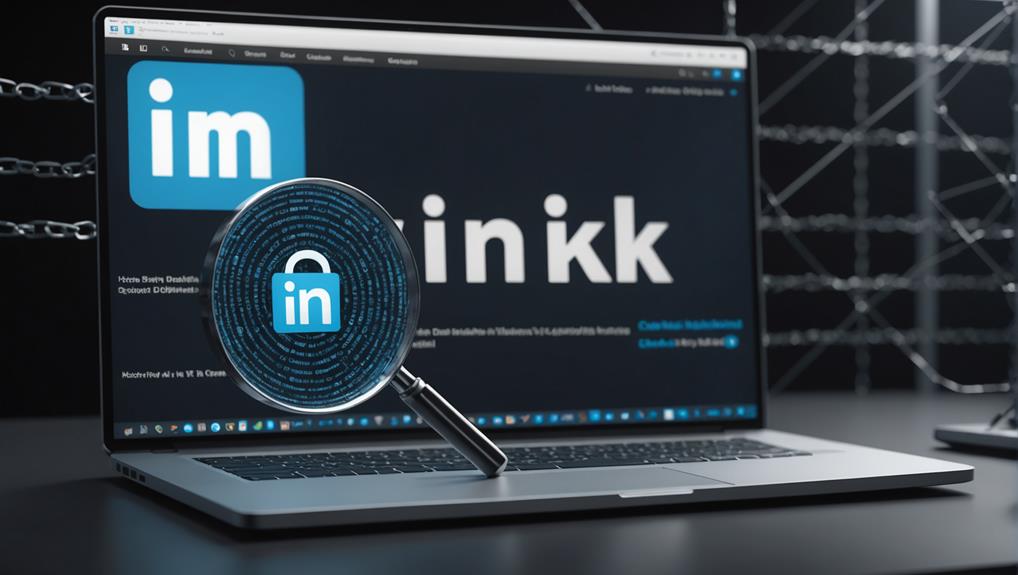
No, you can't see who Googled your LinkedIn profile. While LinkedIn does offer the ability to see who's viewed your profile directly, it doesn't track or reveal details about who searches for you on Google or other search engines. This is mainly because Google doesn't share personal data about its users' searches, keeping such interactions private. The visibility of your profile can be controlled through LinkedIn's own privacy settings, allowing you to manage who sees what. By fine-tuning these settings, you're better positioned to protect your information and discern how your professional narrative is perceived online. Understanding more about profile views can illuminate aspects of your professional presence you may have overlooked.
Understanding LinkedIn's Privacy Tools

LinkedIn offers several privacy tools that let you control who sees your activity and how your information is shared. When you're navigating the professional world, it's comforting to know you're not out there on your own. By adjusting your settings, you can manage the visibility of your profile and updates, ensuring that you're sharing what you want with the people you choose.
You can limit your network visibility, which means you decide whether your connections see your network list or not. This feature is particularly useful if you prefer maintaining a discreet professional circle, fostering a sense of safety and exclusivity. Additionally, you can adjust who sees your posts and updates. Whether it's a new job update, a shared article, or a career milestone, you control who celebrates these moments with you. You can share them publicly, with your connections, or just with a select group.
These settings empower you to cultivate a professional environment that feels secure and supportive. You're building not just a network, but a community where you can thrive. With LinkedIn's privacy tools, you're in charge of your professional narrative, ensuring you connect authentically and meaningfully with others in your field.
What LinkedIn Profile Views Show
When you check your profile views on LinkedIn, you'll see a list of people who have recently viewed your profile, along with some basic information about them. This might include their name, headline, location, and how they found your profile. It's a chance to see who's taking an interest in you, which can be quite affirming.
You're not just a face in the crowd; you're someone people want to connect with. Each view represents a person who might be looking for the skills and experiences you bring to the table. This can be a powerful motivator to enhance your profile and engage more on the platform. Remember, every notification of a profile view is a potential opportunity for networking, collaboration, or even a new career path.
Moreover, the insights you gain from these views can help you understand what aspects of your profile are attracting attention. Are viewers from a specific industry or company? This information can guide you in tailoring your profile more strategically to appeal to the right audience. Embrace these connections, reach out, and expand your professional circle. You're part of a community here, and every interaction counts.
How Google Searches Work

Understanding how Google searches function helps you grasp why specific LinkedIn profiles appear in your search results. When you type a name or keyword into Google, you're not just sending out a digital feeler into the void. Instead, you're tapping into a vast, interconnected network that mirrors our own social interactions.
Imagine you're part of a massive community where everyone's known for something unique—a skill, a job, a network. When you search, Google acts like the community connector. It sifts through billions of web pages, looking for the ones that best match your query. But it's not just about matching keywords. Google also considers how relevant and authoritative each page is. This is similar to how you might value advice from someone well-respected in your community over a stranger.
Google's algorithms analyze links between pages to determine this authority, much like how reputation spreads through word of mouth in social circles. The more high-quality sites that link to a page, the higher it might rank. So, when a LinkedIn profile comes up in your search, it's likely because many trusted sites have pointed Google in that direction. It's all about connectivity, both online and off, pulling us into a larger narrative where every search connects back to you and your community.
Can Google Reveal Searchers?
You might now wonder if Google can disclose who has searched for your LinkedIn profile. The short answer is no, Google doesn't provide personal data about who conducts specific searches. This might feel a bit isolating, especially when you're trying to connect and engage with others in your professional circle. However, this also means that your own searches remain private.
It's natural to want to know who's taking an interest in your professional life. You're not alone in this. Many professionals feel the same way, longing to identify opportunities and build relationships. While Google can't help with identifying specific individuals, you can still get a sense of your profile's visibility and reach through other tools that are designed to enhance your sense of community and connection.
For instance, LinkedIn itself offers features that let you see who has viewed your profile, provided they haven't opted for anonymity in their privacy settings. This feature can be particularly useful. It allows you to see potential connections and grow your network, which is crucial in building a sense of belonging and advancing your career. So, while Google won't tell you who's searching, LinkedIn steps in to bridge that gap.
Privacy Concerns With Linkedin

Considering LinkedIn's extensive network, it's critical to be aware of the privacy concerns associated with sharing your professional information online. You're part of a vast community where your details can be seen by countless users, from potential employers to colleagues. It's essential to know how your data is used and who can access it.
When you join LinkedIn, you share various personal details, aiming to connect and belong in professional circles. However, this openness may expose you to risks if your settings aren't managed carefully. Are you aware of who can view your posts, comments, or even your profile updates? It's wise to regularly check your privacy settings to ensure they align with your comfort levels and professional boundaries.
Don't forget, the information you share can often leave a digital footprint, leading to unintended visibility. You should feel secure in your professional community, knowing you control what you share and with whom. Engage with features that allow you to customize your visibility on the platform, reinforcing your sense of security among your network. Remember, being informed and cautious helps you protect your professional identity while still enjoying the benefits of belonging to LinkedIn's global community.
Third-Party Tracking Tools
Third-party tracking tools can monitor your activity on LinkedIn, providing insights into who views your profile and when. These tools are designed to make you feel more connected to your network by revealing who's interested in your professional journey. It's like knowing who's knocking at your door, allowing you to welcome them into your professional circle with open arms.
Imagine you've posted about a recent career achievement or shared an article that's close to your heart. You're naturally curious about who took notice, aren't you? These tracking tools can satisfy that curiosity by showing you exactly who's engaging with your content. This isn't just about numbers and names; it's about understanding the impact you're making on others within your industry and beyond.
Enhancing Your LinkedIn Security

While exploring who's viewed your profile, it's crucial to bolster your LinkedIn's security settings to protect your private information. You're part of a community here, and it's vital to ensure that your interactions remain safe and your data secure.
Firstly, regularly update your password and consider using a strong, unique combination that you don't use elsewhere. This simple step can significantly reduce the risk of unauthorized access to your account.
Next, take a moment to review your privacy settings. LinkedIn allows you to control who sees your activity, who can send you invitations, and how your profile appears to others, including search engines. Tailoring these settings helps you maintain control over your online presence and how you're perceived within your professional community.
Additionally, enable two-factor authentication (2FA) for an added layer of security. With 2FA, even if someone gets hold of your password, they won't easily access your account without also having your phone.
Misconceptions About Profile Tracking
Many people mistakenly believe that LinkedIn allows you to see who has Googled your profile, but this isn't the case. You're not alone if you've ever wished for this feature, imagining the relief and control it could provide. It's a common misconception that feeds into our desire to connect more meaningfully and protect our professional sphere.
Moreover, some assume LinkedIn's profile views feature extends to external searches, which isn't true either. This confusion is understandable. You want to know who's taking an interest in your professional life, thinking it might lead to better opportunities or collaborations. LinkedIn, however, only shows data on who views your profile through the platform itself.
It's important to remember that while LinkedIn provides tools to see who within the network interacts with your profile, no service, including LinkedIn, can track who searches for your name on search engines like Google. This misconception might make you feel out of the loop, but you're actually in good company—everyone's in the same boat.
Understanding these limits helps set realistic expectations about what you can control, allowing you to focus on nurturing the connections you do have. This knowledge isn't just empowering—it's a shared experience that ties all LinkedIn users together.
Managing Your Online Visibility

You can enhance your online visibility by adjusting your LinkedIn privacy settings to control what others see. Remember, it's all about creating a space where you feel both safe and connected. By carefully choosing what details to share, you're not only protecting your information but also crafting the narrative of your professional journey. This control helps you connect with others on your own terms, ensuring you're seen in the light you wish to be seen.
To start, dive into your LinkedIn settings. Here, you can decide who can view your profile, updates, and even who gets to see your connections. It's like setting the stage for your own professional story. You can also manage how your profile appears in search engine results, making it easier for the right people to find you, connect, and belong to your network.
Being proactive about your online presence means you're part of a community that respects each other's boundaries. It's about making meaningful connections without compromising your privacy. By being selective about what you share, you're not isolating yourself; instead, you're ensuring every connection you make is more intentional and, ultimately, more rewarding.
Future of Digital Privacy Rights
Digital privacy rights are evolving rapidly as technology advances, impacting how your personal information is protected online. You're part of a digital society where sharing is the norm, but so is the worry about who else might be peeking into your digital life. The good news? Regulators and tech companies are increasingly recognizing your need to belong safely in this shared digital space.
In the near future, you can expect stronger laws and clearer guidelines to ensure your data is treated with the respect it deserves. Imagine a world where your consent isn't just a formality but a genuine choice you make about what to share and with whom. You won't just be another face in the crowd; you'll be an empowered user, actively shaping your online environment.
Tech developers and policymakers are starting to see you not just as users or consumers, but as community members with voices that matter. This shift means that your concerns and needs for privacy and security are becoming central in the design of new technologies and regulations. You're not just on the receiving end anymore. You're a key player in the digital world, ensuring that as we all connect more, we also protect what makes you uniquely you.
Conclusion
You can't see who's Googled you, but LinkedIn does let you know who's viewed your profile if they haven't hidden their identity. Always remember, Google won't share who searched for you. Take control of your privacy on LinkedIn by adjusting your settings and stay informed about your digital footprint. As privacy concerns evolve, keep an eye on future changes in digital privacy rights to ensure you're always a step ahead in managing your online visibility.






